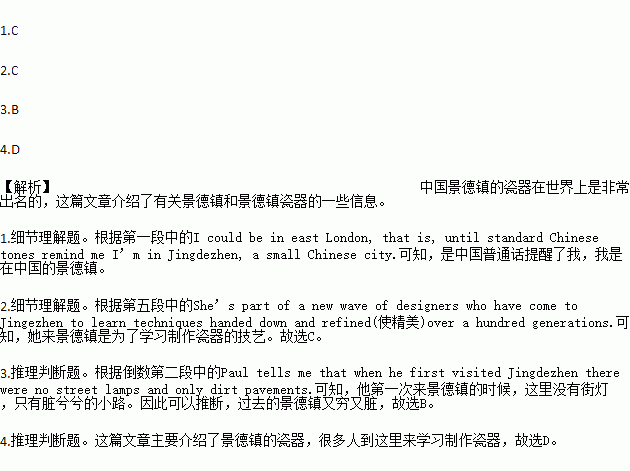题目内容
It’s Saturday morning in a large courtyard. Young designers sell their creations, from fine tea sets to hand-pained ceramic(瓷质的) earrings. I could be in east London, that is, until standard Chinese tones remind me I’m in Jingdezhen, a small Chinese city.
Centuries ago, when Europeans first saw Chinese porcelain, for example, it seemed so fine that they concluded it must have been made with magic and called it “white gold”.
They couldn’t find out how it was made, but they knew where it came from: the town of Changnan. Changnan porcelain was so in demand that early traders began calling the whole country by this town’s name, mixed by foreign tongues, Changnan transformed into China.
Two million years after porcelain’s invention, the town, now called Jingezhen, is still one of the world’s most important centres for porcelain production.
“The people are the most important treasure here, their roots are deep in history,” says Zhang Jia. She’s part of a new wave of designers who have come to Jingezhen to learn techniques handed down and refined(使精美) over a hundred generations. “This is the best place to study porcelain in China, perhaps in the entire world.” She adds.
Chinese artists aren’t the only ones drawn here. Founded in 2005 by Caroline Cheng, the Pottery Workshop runs classes for visitors from around the world.
In the Pottery Workshop’s second floor studio, I meet Trudy Golley and Paul Leather, a husband-wife duo from Canada. Paul tells me that when he first visited Jingdezhen there were no street lamps and only dirt pavements. There were workshops but their goods were bought by traders and sold on elsewhere. These days, stylish cafés and bars pop up next to concept stores. At one such shop, I admire some tiny teacups settling on a thick wooden branch like birds.
With the popularity of the Pottery Workshops, China’s young people are more interested in unique, individually-made products. Many of the designers are using Jingdezhen’s master craftsmen(工匠) to make them because they know they offer quality, attention to detail.
1.What made the writer realize that he was in China?
A. Fine tea sets. B. Hand-painted ceramic earrings.
C. Standard Chinese. D. Fine Chinese porcelain.
2.Zhang Jia came to Jingdezhen in order to _________.
A. know something about Jingdezhen’s history
B. enjoy the beautiful scenery of Jingdezhen
C. study techniques of making porcelain
D. pay a visit to some of her foreign friends
3.From what Paul said we can learn ____________.
A. many foreign visitors came to Jingdezhen to study porcelain
B. in the past Jingdezhen was a poor and dirty town
C. their goods were not popular in western countries
D. China’s young people are more interested in unique products
4.What is the purpose of the passage?
A. To appeal to people to buy Chinese porcelain.
B. To tell people traditional Chinese porcelain earns great reputation in Jingdezhen.
C. To advertise porcelain products in Jingdezhen.
D. To introduce some information about one traditional Chinese art in Jingdezhen.

